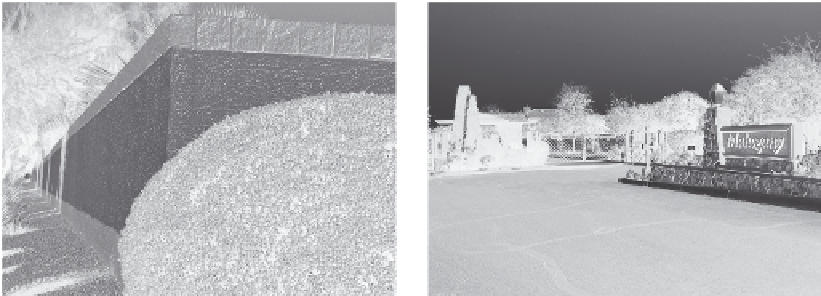Environmental Engineering Reference
In-Depth Information
(a)
(b)
FIGURE 19.6
(a) Walls can separate people from each other. (b) Gates provide security, but they also can keep people from
connecting to the community.
19.3.8 Walls and Gates
We all believe in property rights, and it is the right of a property owner to define their
property in some fashion with walls and gates. Everywhere you go in the Southwest,
developments are surrounded by fences, gates, and walls. In the days of the Wild West,
fences and walls were required to keep the bad guys out and the livestock in. Now, to some
extent, these same features continue this same protection-based design based on fear of
“the outside.” I would argue the ubiquitous presence of walls and gated communities are
contributing to the isolation of segments of the community, rather than helping to relate
to each other by developing personal connection and understanding of fellow community
members. A postmodern neighborhood design has few walls and low fences that define
the property, but still allows for dialogue among neighbors. We should thoughtfully
consider whether the number of walls and gates we have really serve the purpose of
building community (Figure 19.6).
19.3.9 Walkable Cities and Transportation Choices
Most Sunbelt cities are designed for the automobile. A man without a car today is like a
man without a horse in the old days—powerless to do anything meaningful in life. The
suburban development pattern of predominantly single-family homes fosters the need
for an automobile to commute for work and commerce. Some are faced with commutes
that can take up to two hours in rush hour traffic to reach the work destination, as the
affordable housing stock is increasingly found along the outskirts of the urbanized zone.
After living this daily grind for several years, there is a growing number of people that
would gladly give up this lifestyle for one that allows for walkable streets that integrate
living and working opportunities and promote connection to other members of the
community. The notion that a single-family home is the ultimate quest is in question, as
more people opt for townhouses, condominiums, and loft apartments in the urban core
as alternatives to cheaper houses on the urban fringe. In addition, providing alternative
transportation modes such as light rail, bus, and bike lanes provides sensible options for

Search WWH ::

Custom Search